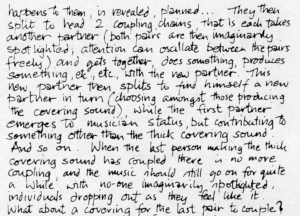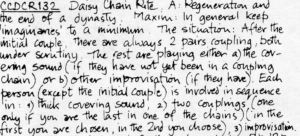Cornelius Cardew and the Scratch Orchestra were vital presences at documenta 14. In Kassel, the score of the composer’s Treatise was not only displayed in the Neue Galerie, but also reproduced on the glass windows of Documenta-Halle, while there were concerts of Cardew’s Thälmann Variations and We Sing For The Future!, on September 8th (I missed it by a day, as I had returned to Athens). In Athens, in the Odeion, the emphasis was focused on the collective practices of the Scratch Orchestra, founded in 1969, including a display of their constitution and founding anthology Nature Study Notes: Improvisation Rites. The latter was at the heart of a three-day workshop in May, led by two original Scratch Orchestra members Carole Finer and Stefan Szczelkun, which you can listen to excerpts of here.
On looking at one of the photos of the performance, I recognized two performers that I met as part of Mattin’s Social Dissonance. Dafni Krazoudi can be seen in the center, scattering papers while Eleni Zervou is lying on the ground, covered in paper, to the right (was this Carole Finer’s ‘newspaper rite’, CFIRT146?). Seeing Dafni and Eleni were part of the workshop (and knowing that another performer for Social Dissonance Ioannis Sarris also attended the performance) made me wonder about the connections between the Scratch Orchestra scores and Mattin’s score for Social Dissonance. As both works were invited to be part of documenta 14 by curator Pierre Bal-Blanc, perhaps the shared experiences of Eleni and Dafni can tell us something about what bridges the two works and their focus on improvisation and ritual?
This then made me think about potential connections between the improvisation rites of the Nature Study Notes and ancient Athens, specifically in terms of contested debates between philosophers about phusis (nature) and nomos (custom).
It was while thinking about these potential connections that I came across one of the rites that Cardew created for the Scratch Orchestra called the Daisy Chain Rite. Here is the description, as well as the note:
When I read this rite, with its alternation of couples and the covering of sound (especially with the problem of how the last couple are ‘covered’?), I was immediately reminded of the anecdote, preserved in Apuleius Florida 14, of the public sex of the Cynic philosophers Crates and Hipparchia. (It was this anecdote that was the basis for my very first paper delivered at the Annual Meeting of the American Philological Association – now the Society of Classical Studies – way back in 2004, called ‘Philosophy in the Bedroom: Sex and Cynicism in the Apuleian Corpus‘). On encountering his master and his partner copulating in the street, Zeno of Citium covered them in his cloak. This act has been interpreted by philosophy historians as marking a symbolic break between Cynicism and a foundational act of Zeno’s Stoicism, especially as Apuleius located the scene in a portico, which may have been the site of the Stoa Poikile, where Zeno would later lecture as a Stoic. During my time in Athens this summer, in addition to experiencing the wonders of documenta 14, I revisited several sites of philosophical learning (e.g. the Academy, the Lyceum) and when I cam to the Stoia Poikile, I was excited to see that there were excavations taking place.
I loved how the sounds of the street mingled with the serious work of the archaeologists, and made this short video that brought the sounds of the street into dialogue with the excavation.
Perhaps within the spirit of learning from Athens, and the continuing legacies of documenta 14, Minus Plato should organize a performance of Cardew’s Daisy Chain Rite, on the site of the Stoa Poikile excavations, combining members of the Scratch Orchestra Odeion workshop and the team of archaeologists working on this site!
POSTSCRIPT
I just had a conversation with Eleni Zervou about her experience in the Scratch Orchestra workshop in Athens and she sent me an interesting e-book written by Stefan Szczelkun that describes recent performances of the Nature Study Notes, with an account of the Athens workshop. Szczelkun also included a section called Eleni’s New Rites which she developed for the workshop and which she presented to the group to choose which ones they wanted to perform:
Eleni’s New Rites
EZ 1. Protest against the creator of the rite/ against the rite itself. Create a “procession”/ demonstration/ riot to express your opposition.
EZ 2. Take a very important decision collectively or individually. Then do the opposite to what you have decided.
EZ 3. Express your gratitude to the institution (if there isn’t one, then make it up).
EZ 4. Breathe collectively.
EZ 5. Everybody in the room uses their voice to sing a single continuous note, different than the ones sung by the people around them. The same note cannot be sung by two people. As an interval do the reverse (everybody sings the same note).
EZ 6. Act Normal.
EZ 7. Be the audience.
The players in the workshop chose to perform numbers EZ 4 and EZ 6. Which ones would you choose?





I found this post very strange! Within what I’d consider an anti-humanist entity like ‘Nature Study Notes’ we have a possible classical reference. I’m not classically educated but I do think neo-classicism at the core of western knowledge, and bourgeoise (literary) culture. It seems to me likely that Cornelius Cardew would have known about this ‘saucy’ story from the Classics when he was at school in Canterbury.
It is also strange because the Daisy Chain rite had no impact on me in the Seventies or later. Thanks for bringing it to my attention – reading it now it seems very interesting!